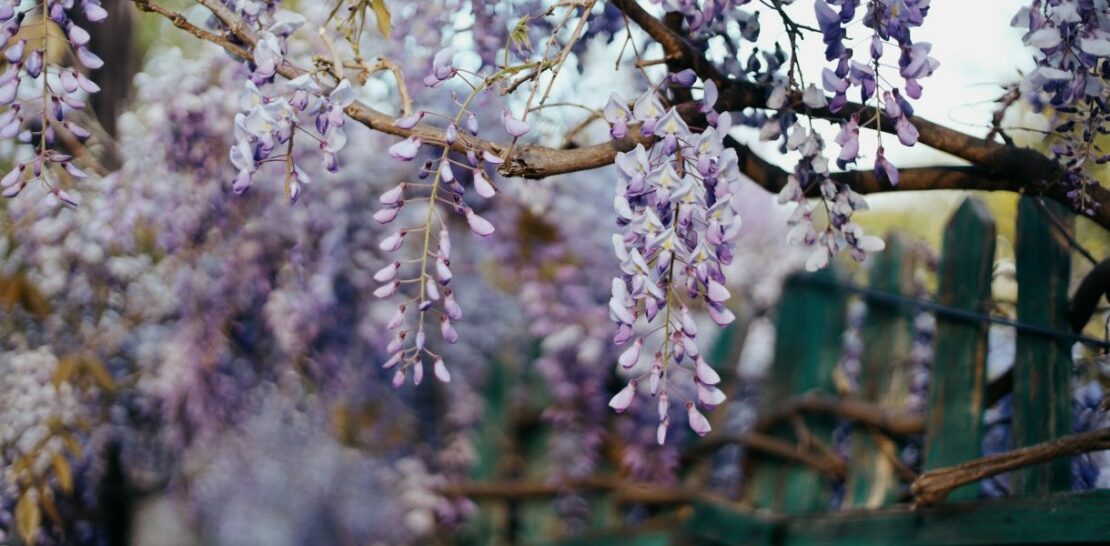Transforming your garden into an enchanting, picturesque space is easier than you might think.
One of the most effective ways to accomplish this is by incorporating fast-growing climbers into your landscape design.
These plants not only add remarkable visual interest, but also provide numerous benefits such as privacy, shade, and even support for other plants.
In this article, we will delve into the world of climbing plants, with a focus on the seven fastest-growing varieties you should consider for your garden.
Read on to learn how these amazing plants can revolutionize your garden’s aesthetics within a short period of time.
1. Wisteria: An Enchanting Cascade of Blooms
Wisteria is a captivating addition to any garden, thanks to its dazzling display of pendulous, fragrant flowers.
Native to Asia and North America, Wisteria is a deciduous climber that quickly grows and covers arbors, pergolas, and walls. Its stunning, cascading blossoms can be found in various shades, including purple, white, and pink. In addition to its visual splendor, Wisteria is also known for its delightful fragrance, which fills the air throughout its blooming season from late spring to early summer.
There are two main species of Wisteria to consider: Wisteria sinensis (Chinese Wisteria) and Wisteria floribunda (Japanese Wisteria). Both species can grow at a rapid rate of 10 feet per year, with proper care and conditions. To ensure success with Wisteria, provide it with full sun, well-drained soil, and regular pruning for optimal growth and flower production.
2. Clematis: The Queen of Climbers
For a regal touch in your garden, look no further than the Clematis, also known as the Queen of Climbers.
- Clematis montana: This vigorous grower is native to the Himalayas and boasts an impressive growth rate of 20 feet per year. Its abundant, fragrant white or pink flowers bloom in late spring, creating a breathtaking display.
- Clematis armandii: Hailing from China, this evergreen climber can reach heights of up to 30 feet in just a few years. Its leathery, dark green leaves provide a striking backdrop for its delicate white or pink flowers, which emit a sweet fragrance in early spring.
- Clematis viticella: This hardy, deciduous variety is native to Southern Europe and thrives in a wide range of conditions. With a growth rate of 10 feet per year, its purple, red, or blue flowers create a stunning display from midsummer to early autumn.
To maximize the potential of your Clematis, plant it in a sunny, sheltered location with rich, well-draining soil. Ensure proper support, such as a trellis or pergola, and prune according to the specific variety’s needs.
3. Golden Hops: A Luscious Green Cascade
Golden Hops, scientifically known as Humulus lupulus ‘Aureus’, is a wonderful choice for those seeking a lush, green, fast-growing climber.
- Growth Rate: This vigorous, deciduous climber can grow up to 20 feet in a single season, quickly covering fences, walls, and other structures.
- Appearance: Golden Hops is known for its striking, golden-yellow leaves, which contrast beautifully against its green, cone-like flowers. The plant’s foliage intensifies in color when exposed to full sun, adding a bold statement to your garden.
- Additional Benefits: Aside from its aesthetic appeal, Golden Hops is also valued for its use in brewing beer, providing both visual interest and practicality to your garden.
For best results with Golden Hops, plant it in well-drained soil and provide ample sunlight. Regular pruning will help maintain the desired shape and encourage new growth.
4. Passiflora: The Exotic Beauty
Introduce an air of tropical allure to your garden with the striking, fast-growing Passiflora, commonly known as Passion Flower.
There are over 500 species of Passiflora, but the most popular and suitable for garden cultivation are the Passiflora caerulea (Blue Passion Flower) and Passiflora incarnata (Purple Passion Flower). These vigorous, evergreen climbers can grow at a rate of 15 to 20 feet per year, quickly gracing your garden with their intricate, exotic blooms.
The flowers of Passiflora are truly a sight to behold, featuring a unique, complex structure with vivid colors that attract pollinators. In addition to their ornamental value, some species also produce edible fruits known as passion fruits, adding another layer of intrigue to these fascinating plants.
Passiflora thrives in full sun to partial shade, with well-drained soil and plenty of moisture. Provide a sturdy support structure, such as a trellis or pergola, to accommodate its rapid growth and allow its breathtaking flowers to take center stage in your garden.
5. Campsis: The Trumpet of the Garden
Add a lively burst of color to your garden with the vibrant, fast-growing Campsis, also known as Trumpet Vine or Trumpet Creeper.
There are two main species of Campsis that are perfect for garden cultivation: Campsis radicans (North American Trumpet Vine) and Campsis grandiflora (Chinese Trumpet Vine). These deciduous climbers can grow at an impressive rate of 10 to 15 feet per year, quickly adorning your garden with their showy, trumpet-shaped flowers.
The flowers of Campsis, which bloom in shades of orange, red, or yellow, are not only visually striking but also attract hummingbirds and other pollinators to your garden. Their rapid growth and dense foliage make them an excellent choice for providing privacy, shade, and natural barriers in your outdoor space.
To ensure the best growth and performance from your Campsis, plant it in a sunny location with well-draining soil. Keep in mind that it can become invasive if not managed properly, so regular pruning and control measures are essential.
6. Lonicera: The Sweetly Scented Serenade
Immerse your senses in the sweet fragrance and enchanting beauty of the fast-growing Lonicera, commonly known as Honeysuckle.
There are numerous species and varieties of Lonicera, both deciduous and evergreen, that can make an excellent addition to your garden. Among the most popular are Lonicera periclymenum (European Honeysuckle) and Lonicera japonica (Japanese Honeysuckle), which can grow at a rapid rate of 10 to 20 feet per year.
Honeysuckle is valued for its tubular, fragrant flowers that bloom in various shades of white, yellow, pink, and red, creating a magnet for pollinators. The flowers are followed by ornamental berries, adding further interest and color to your garden. Its twining, vining habit allows it to easily climb and cover structures, adding a romantic, cottage-garden charm to your landscape.
For the most successful cultivation of Lonicera, provide it with a sunny to partially shaded location, well-drained soil, and regular pruning to encourage new growth and prevent overgrowth.
7. Jasminum: The Fragrance of Elegance
Infuse your garden with the intoxicating scent and graceful beauty of the fast-growing Jasminum, also known as Jasmine.
Many species and varieties of Jasminum exist, but some of the most popular for garden cultivation are Jasminum officinale (Common Jasmine) and Jasminum polyanthum (Pink Jasmine). These versatile climbers can grow at a rate of 10 to 15 feet per year, quickly gracing your garden with their delicate, star-shaped flowers.
Jasmine is renowned for its exquisite fragrance, which can fill your entire garden with its sweet, captivating scent. The flowers, which bloom in shades of white or pink, are also visually appealing, creating a stunning contrast against the plant’s glossy, dark green foliage.
To achieve the best results with Jasminum, plant it in a sunny to partially shaded location with fertile, well-draining soil. Provide a strong support structure, such as a trellis or pergola, and prune regularly to maintain itsshape and encourage new growth.
In conclusion, the incorporation of fast-growing climbers into your garden can yield breathtaking results in a relatively short period of time. With their rapid growth, enchanting flowers, and numerous benefits, these seven climbers – Wisteria, Clematis, Golden Hops, Passiflora, Campsis, Lonicera, and Jasminum – offer incredible potential for transforming your garden into a captivating, picturesque paradise. By selecting the appropriate species and providing the necessary care and conditions, you will be well on your way to creating a garden that not only looks stunning but also supports a thriving ecosystem of pollinators and other beneficial organisms. Embrace the power of these swiftly flourishing climbers and watch as your garden is revolutionized before your very eyes.




